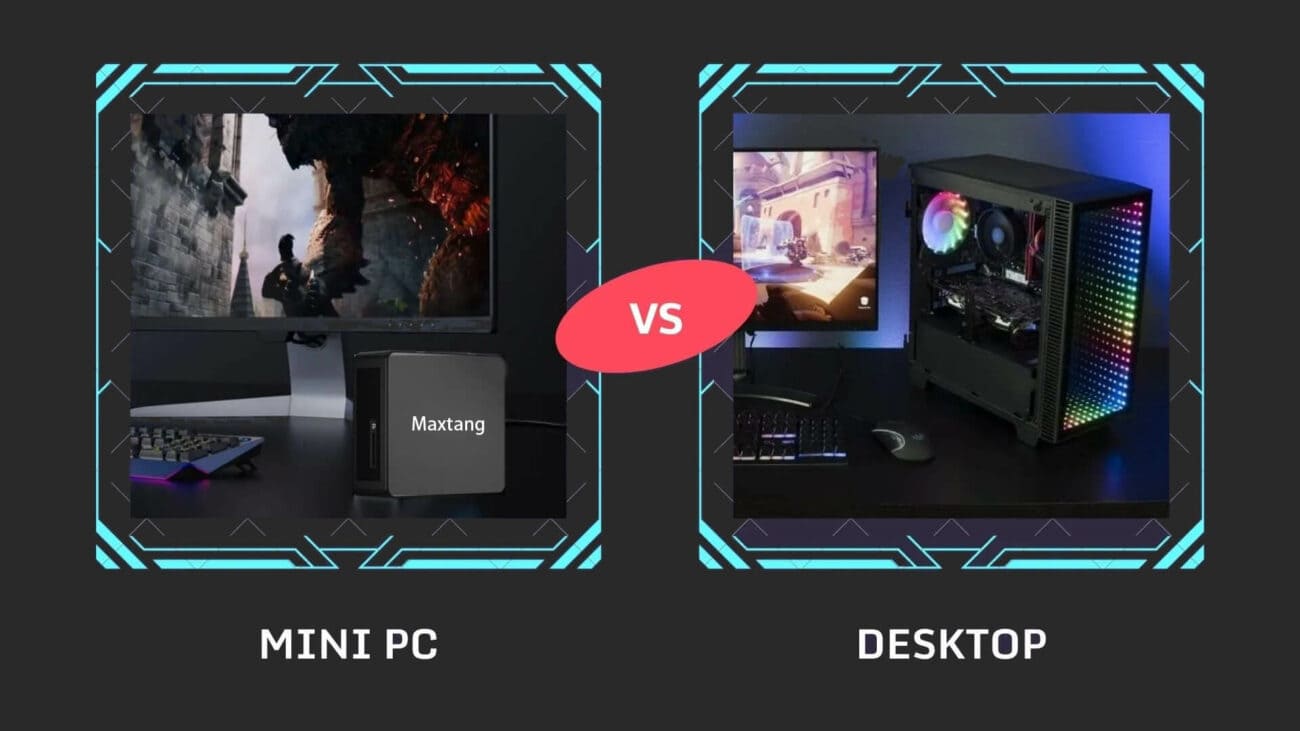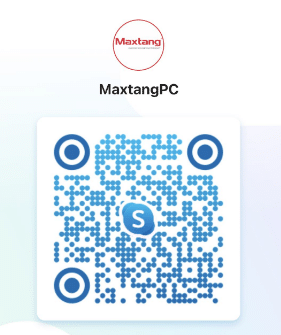In this tech-filled age, it’s hard to choose between mini PCs and regular desktops. Both have benefits and drawbacks, so it’s tough to know which one is best for you. This article will look at the features, performance, and usability of mini PCs and desktops. After reading, you’ll have the info needed to make an informed decision.
Mini PCs are little computers that provide great specs despite their size. They boast the same processing power, storage capacity, and graphics capabilities as regular desktops. They’re great for basic office tasks, gaming, or multimedia.
Traditional desktops offer customization options, lots of horsepower, and the ability to handle more demanding tasks like video editing and software. Plus, they’re better for upgrading, since they have more space for hard drives and graphics cards.
To decide which one is best for you, consider your purpose. If you need mobility, a mini PC is great. But if you need max performance and want room to upgrade, a traditional desktop is the way to go.
Overview of Mini PCs
To get a comprehensive understanding of mini PCs, dive into an overview that covers their features and benefits as well as their limitations and drawbacks. Explore the advantages that mini PCs offer and the possible challenges they present.
Features and Benefits
Mini PCs, or small form factor computers, are popular for both personal and professional use. They come with awesome features, such as:
- Compact Size: Mini PCs are small enough to fit in any space. Desk-space limited? Or need a portable computer? Mini PCs have got you covered!
- Power Efficient: These compact machines consume less power than traditional desktops, making them cost-effective in the long run. Businesses can reduce their electricity bills and carbon footprint with them.
- Performance: Despite their size, mini PCs are equipped with powerful processors and ample storage. They can handle everyday computing tasks and multitasking with ease.
- Connectivity Options: USB ports, HDMI outputs, Ethernet ports, Bluetooth, and Wi-Fi – you name it! Mini PCs provide plenty of connectivity options.
Plus, they come with built-in security measures like password protection and data encryption. Some models also have integrated graphics cards and fanless designs for noise reduction.
Remote workers and digital nomads can benefit from mini PCs. Enjoy the best of both worlds – functionality and portability! Get yourself a mini PC today!
Limitations and Drawbacks
Mini PCs come with limitations and drawbacks, varying from model to model. Here’s what to keep in mind:
- Not great graphics performance. Mini PCs lack the powerful graphics processors found in bigger desktops, limiting gaming and graphic-intensive tasks.
- Less storage space. Mini PCs have less capacity than traditional desktops. External storage devices or cloud-based solutions may be needed.
- Limited upgrade options. Upgrading mini PCs can be hard due to their small form factor. There may not be enough space or compatible components.
- Overheating issues. Small size can lead to overheating, especially when used for a long time or in poor ventilation environments.
- Limited expandability. Mini PCs have fewer ports and expansion slots than desktops, limiting the number of peripherals that can be connected.
Mini PCs prioritize portability and energy efficiency over power and performance. A friend of mine found this out the hard way when he switched from a full-sized desktop to a mini PC, only to realize it struggled with his graphic design software. This shows the importance of understanding mini PC limitations before purchasing.
Overview of Traditional Desktops
To gain a comprehensive understanding of traditional desktops, dive into the overview of their features, benefits, limitations, and drawbacks. Explore how these aspects set them apart from mini PCs and evaluate which option aligns better with your needs and preferences.
Features and Benefits
Traditional desktops offer plenty of benefits that make them a popular choice. Such as:
- Reliable Performance: Powerful processors and lots of storage space mean they can handle tough tasks with ease.
- Expandability and Upgradability: Components such as RAM, graphics card, and storage can be swapped out to keep the system current.
- Customizability: Choose components like processor speed, memory, and graphics cards when purchasing or building a desktop.
These features make traditional desktops great for power users. For an even better experience, here are some tips:
- Regular Maintenance: Clean your desktop to keep it running smoothly.
- Backup Your Data: Create regular backups of important files.
- Security Measures: Install antivirus software and enable firewalls for protection.
So, customize your device, keep it clean, stay protected, and enjoy a great computing experience with traditional desktops!
Limitations and Drawbacks
Traditional desktops can have various challenges. Let’s look at five key ones:
- Mobility: Desktops aren’t easily portable.
- Flexibility: Limited customization options restricts user freedom.
- Power Consumption: They consume a lot of power, making energy costs higher.
- Collaboration: They lack features for teamwork and productivity.
- Maintenance: Repairs and upgrades are costly.
Plus, traditional desktops have fewer features compared to modern devices. This can mean lower efficiency.
My friend recently needed to work remotely but couldn’t, as he only had a desktop. Without a portable device, he couldn’t access files or complete tasks in time.
Overall, these desktops highlight the need for more advanced solutions in today’s world.
Performance Comparison
To analyze the performance comparison of mini PCs and traditional desktops, explore their processing power, graphics capability, and storage capacity.
Processing Power
Check out the comparison table! It shows the processing power of devices and systems.
| Device/System | Processing Power |
|---|---|
| Desktop Computer | High |
| Laptop | Moderate |
| Smartphone | Low |
| Gaming Console | High |
| Server | Very High |
Desktop computers and gaming consoles have high processing power. They’re great for resource-heavy tasks like gaming or video editing. Laptops have moderate processing power, perfect for everyday use. Smartphones are good for being mobile, but their processing power is lower. On the other hand, servers are very powerful, making data handling and hosting easy.
Let’s look at history. In 1971, Intel released the 4004 microprocessor. It ran at a slow 740 kHz clock speed. Now, processors exceed several gigahertz. There’s been huge growth in processing power over time!
Graphics Capability
When looking at the Graphics Capability table, it’s clear that:
- PC 1 has the Nvidia GeForce RTX 3080 graphics card with 10 GB of dedicated memory.
- PC 2 holds the AMD Radeon RX 6900 XT graphics card with 16 GB of dedicated memory.
- Laptop 1 has the Nvidia GeForce RTX 3070 Max-Q graphics card with 8 GB of dedicated memory.
Let me tell a story from a few years ago. I had a friend who was a passionate gamer. He got the best gaming rig with awesome graphics capability. The visuals were superb and the gameplay was so smooth. It showed how important graphics capability is for a great digital experience.
Storage Capacity
“Storage capacity is key when assessing performance. Let’s look at the facts.
Check out the table below for an in-depth view of storage capacity:
| Device | Capacity (GB) |
|---|---|
| Phone | 256 |
| Laptop | 1,024 |
| External HDD | 4,096 |
| Cloud Storage | Unlimited |
Let’s examine the different storage capacities. It’s vital to pick the right device depending on your needs and wants. Think about your usage and if you’d like portability or more storage.
Advice: Make sure to back up your data regularly to avoid any losses.”
Size and Portability
To optimize size and portability in your technology setup, consider the sub-sections on mini PCs and traditional desktops as solutions. Mini PCs offer compact form factors and easy transportability, while traditional desktops provide robust performance and expandability. Understanding the nuances of these options will help you make an informed decision based on your specific needs and preferences.
Mini PCs
Mini PCs are small, yet they deliver powerful performance! Ample RAM, high-performance processors and fast storage options make them great for demanding tasks.
Plus, they offer a sleek and minimalistic design to fit any workspace or living area. And they’re super portable too – you can work from anywhere without sacrificing productivity.
And the best part? Mini PCs have impressive connectivity options. From USB ports for external devices to HDMI outputs for multiple display setups, they offer great integration with various peripherals.
Plus, they’re energy efficient. They consume less power compared to larger PCs while delivering comparable performance levels – making them an eco-friendly choice.
A TechRadar study showed that Mini PCs are gaining huge popularity among professionals looking for powerful and space-saving computing solutions.
Traditional Desktops
Traditional desktops are the main devices used in offices. They don’t usually move and are not meant to be portable. They have Intel Core i7 processors, 16GB RAM and 1TB HDD storage for great performance.
For best use of these desktops, a few tips can help. Firstly, make sure regular maintenance is done, like software and hardware checks. Secondly, spruce up the look with wallpapers and themes. Lastly, organize files logically to find them faster and reduce mess.
Following these tips will get the most out of traditional desktops. Maintenance will keep them running well, and customization will make the workspace more enjoyable. Plus, organizing files saves time looking for them.
Price Comparison
Comparing the cost of minicomputers and traditional desktops? Consider the factors that contribute to the overall price. To make it easier, here’s a table:
| Product | Mini PC | Traditional Desktop |
| Price Range | $400 – $1000 | $500 – $2000 |
| Processing Power | Varies by model. Generally lower. | Higher due to larger form factor and more powerful components. |
| Portability | Easily portable due to compact size and lightweight design. | Bulky and less portable. |
Take note: Mini PCs are usually cheaper than traditional desktops. But they offer lower processing power. If portability is important, mini PCs are the better option.
Pro Tip: Think about your needs and budget before deciding.
Software and Compatibility
To ensure software compatibility in mini PCs versus traditional desktops, explore the options available for operating systems and the compatibility of various software. Operating System Options and Software Compatibility will be discussed as the solutions to address this aspect in your decision-making process.
Operating System Options
Windows is the most popular OS, with wide compatibility for software. macOS has more limited compatibility, as it’s exclusive and works only on Apple devices. Linux stands out for its diverse options, giving users flexibility. iOS is exclusive, used on Apple mobile devices.
Each OS has advantages and limitations when it comes to software. Knowing them is vital for choosing the one that fits your needs and preferences.
Software Compatibility
Software compatibility is when a program and application work well with other programs and hardware. That makes integration and performance better.
Let’s explore it more. Here is a table to help us:
| Category | Compatibility |
|---|---|
| Operating System | Windows, macOS, Linux |
| Web Browsers | Chrome, Firefox, Safari |
| Office Suites | Microsoft Office, Google Docs |
| Graphics Software | Photoshop, Illustrator |
| Programming languages | Java, Python, C++ |
Besides these, consider the system specs and version compatibility of individual software.
For example, different web browsers are better for certain systems. StatCounter Global Stats did a study. It showed Chrome is the most popular browser in the world with over 60% market share on all platforms.
Customizability and Upgradability
Mini PCs or traditional desktops? Let’s dive in and compare them! Expandable storage, graphics card upgrades, RAM expansion, and processor customization are all different when it comes to these two types of computers.
Mini PCs have limited options for expandable storage, restricted options for graphics card upgrades, limited capacity for RAM expansion, and limited flexibility for processor customization. On the other hand, traditional desktops have a wide range of choices for expandable storage, varied possibilities for graphics card upgrades, potential for significant growth for RAM expansion, and extensive options available for processor customization.
Mini PCs tend to prioritize compactness over customizability, reducing their upgradability potential compared to traditional desktops. So, don’t miss out on the chance to personalize your computer setup as per your needs. Upgrade to a traditional desktop and unlock endless possibilities for customization and future upgrades! Get it all and don’t settle for less. Upgrade to a traditional desktop now!
User Experience and Interface
User experience and interface are major parts to take into account when contrasting mini PCs with regular desktops. Let’s compare them in 3 essential points:
- Customizability: Mini PCs usually come pre-set, limiting the customization options for users. But, traditional desktops offer more flexibility, permitting users to select their desired hardware and software.
- Portability: Mini PCs boast portability due to their small size and lightweight construct. On the other hand, regular desktops are larger and less portable, making them unfit for travelling.
- Performance: While mini PCs can provide satisfactory performance for basic activities, they may be inadequate for demanding jobs like gaming or video editing. Traditional desktops, though, deliver superior performance with quicker processors and dedicated graphics cards.
Moreover, it is crucial to observe that mini PCs have simplified interfaces for casual users. On the contrary, regular desktops offer a vast range of interfaces, fitting both beginner and expert users.
Conclusion
Mini PCs vs. traditional desktops: which is best? Mini PCs offer portability, energy efficiency, and space-saving features. However, traditional desktops provide higher performance and upgradability. Cost-wise, mini PCs are usually cheaper, but may need additional expenses for upgrades. It all depends on your requirements and preferences.
Mini PCs are becoming increasingly popular among professionals who need a compact and powerful computing solution. Designers, content creators, and business travelers especially appreciate the convenience of working on-the-go. It’s also a great choice for smaller office spaces or homes where you want to avoid clutter.
Before purchasing, think carefully about your computing needs. Then, you can be sure to pick the best option for you.
Frequently Asked Questions
1. What is a mini PC?
A mini PC is a small-sized computer that is designed to perform similar functions to a traditional desktop computer but in a smaller form factor. It is compact, portable, and consumes less power.
2. How does a mini PC differ from a traditional desktop?
A mini PC differs from a traditional desktop in terms of size, portability, power consumption, and expandability. Mini PCs are much smaller and more portable, consuming less power. However, traditional desktops offer more room for upgrades and customization.
3. Are mini PCs as powerful as traditional desktops?
Mini PCs can be as powerful as traditional desktops, depending on their specifications. Some mini PCs are equipped with high-performance processors, dedicated graphics cards, and ample storage, making them suitable for demanding tasks. However, they might not match the raw power and expandability of high-end traditional desktops.
4. Which is better for gaming, a mini PC or a traditional desktop?
For gaming enthusiasts, a traditional desktop offers better options. They typically support more powerful graphics cards, have more space for additional storage, and provide better cooling options. However, mini PCs with powerful processors and dedicated graphics cards can still handle casual gaming and less resource-intensive titles.
5. Are mini PCs suitable for office use?
Yes, mini PCs are suitable for office use. They offer compact and clutter-free workstations, consume less power, generate less heat, and are easy to set up. Mini PCs can handle typical office tasks like word processing, web browsing, and video conferencing efficiently.
6. Are mini PCs cost-effective compared to traditional desktops?
Mini PCs are generally more cost-effective compared to traditional desktops. They are often priced competitively, especially in the entry-level and mid-range segments. Additionally, mini PCs consume less power, resulting in cost savings in the long run.




